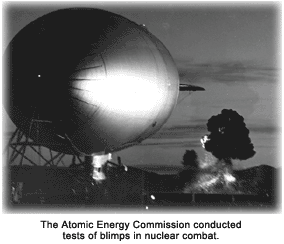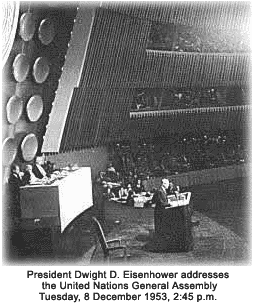Soon after his inauguration, President Dwight D. Eisenhower realized that the rapid development of nuclear weapons after World War II was leading the world on a path to destruction. In order to persuade the American people to accept steps towards arms control, he felt it was essential that they were told the true magnitude of the destructive power that had been developed. In his Atoms for Peace speech to the United Nations on December 8, 1945, Eisenhower combined that warning with a hopeful plan for turning atomic energy into a benefit to mankind.
The bombing of Hiroshima, Japan, on August 6, 1945, ushered in the atomic age of weaponry. Sole possession of such weapons remained with the United States until August 29, 1949, when the Soviet Union exploded its own atomic bomb. In response, the United States began a crash program to develop a Hydrogen Bomb. The first such thermonuclear device was tested at Enewetak Atoll, a small island in the South Pacific, on November 1, 1952. The blast vaporized the atoll and left a crater in the sea bed more than a mile wide. The energy release was estimated at 10.6 megatons of TNT, about 750 times that of the Hiroshima bomb.
 Concerned about the growth of both the Soviet and American nuclear arsenals, Secretary of State Dean Acheson established the General Advisory Committee to discuss new approaches to nuclear disarmament and control. J. Robert Oppenheimer, the original scientist from The Manhattan Project, was made its head. After more than half a year of deliberations, the Oppenheimer panel presented its report on January 15, 1953, just before Eisenhower`s inauguration.
The report offered several observations. It declared that due to the great increase in the production of fissile materials by both sides, it was no longer practical to verify a nuclear disarmament treaty because of the difficulty in accounting for all the material that had been produced. It further concluded that a danger existed that the Soviet Union might deliver a "knock-out blow" to the United States, even with the strong defenses erected against them. Efforts to curtail the arms race were important, and the general public would have to be advised of the dangers of the situation in order to enlist their support.
The committee recommended that the administration advise the public of the looming crisis, release information concerning its existing arsenal, and begin discussions with the Soviet Union on nuclear arms control. Eisenhower gave the task of writing the required speech to C. D. Jackson, who had developed drafts of the address when the Soviet Union announced its own H-bomb test on August 29, 1953.
Within the administration, opponents of Operation Condor, as the speech had been dubbed, now opined that any honest description of the situation would traumatize the public. Eisenhower also realized that a grim depiction would require an offsetting element of hope. To this end, he developed the idea of a "uranium bank." The world`s total available supply of fissile material was considered to be a limiting factor on the growth of nuclear arsenals. Eisenhower decided that if both sides would contribute substantial amounts to a depository, under international control and dedicated to peaceful purposes, it would produce arms control without necessitating inspections that the Soviet Union would be unlikely to accept.
After consulting with the British and French and obtaining their support, Eisenhower arranged for an address to the U.N. General Assembly. On December 6, 1953, he addressed an audience of some 3,500 people. He began by making clear the power of America`s nuclear arsenal. He then provided a graphic description of the future of the world if the two atomic colossi continued on their collision course.
The dark warnings were followed by a hopeful alternative. Eisenhower proposed that both parties draw on their stockpiles of fissile materials to make contributions to an International Atomic Energy Agency, which would be connected to the United Nations. This material would be used by the agency to promote the peaceful pursuits of mankind, applying it to the needs of agriculture, medicine, and other peaceful activities. Nuclear Power would bring electricity to power-starved areas of the world. By finding peaceful uses for the atom, the inventiveness of man would be dedicated to life rather than death.
Concerned about the growth of both the Soviet and American nuclear arsenals, Secretary of State Dean Acheson established the General Advisory Committee to discuss new approaches to nuclear disarmament and control. J. Robert Oppenheimer, the original scientist from The Manhattan Project, was made its head. After more than half a year of deliberations, the Oppenheimer panel presented its report on January 15, 1953, just before Eisenhower`s inauguration.
The report offered several observations. It declared that due to the great increase in the production of fissile materials by both sides, it was no longer practical to verify a nuclear disarmament treaty because of the difficulty in accounting for all the material that had been produced. It further concluded that a danger existed that the Soviet Union might deliver a "knock-out blow" to the United States, even with the strong defenses erected against them. Efforts to curtail the arms race were important, and the general public would have to be advised of the dangers of the situation in order to enlist their support.
The committee recommended that the administration advise the public of the looming crisis, release information concerning its existing arsenal, and begin discussions with the Soviet Union on nuclear arms control. Eisenhower gave the task of writing the required speech to C. D. Jackson, who had developed drafts of the address when the Soviet Union announced its own H-bomb test on August 29, 1953.
Within the administration, opponents of Operation Condor, as the speech had been dubbed, now opined that any honest description of the situation would traumatize the public. Eisenhower also realized that a grim depiction would require an offsetting element of hope. To this end, he developed the idea of a "uranium bank." The world`s total available supply of fissile material was considered to be a limiting factor on the growth of nuclear arsenals. Eisenhower decided that if both sides would contribute substantial amounts to a depository, under international control and dedicated to peaceful purposes, it would produce arms control without necessitating inspections that the Soviet Union would be unlikely to accept.
After consulting with the British and French and obtaining their support, Eisenhower arranged for an address to the U.N. General Assembly. On December 6, 1953, he addressed an audience of some 3,500 people. He began by making clear the power of America`s nuclear arsenal. He then provided a graphic description of the future of the world if the two atomic colossi continued on their collision course.
The dark warnings were followed by a hopeful alternative. Eisenhower proposed that both parties draw on their stockpiles of fissile materials to make contributions to an International Atomic Energy Agency, which would be connected to the United Nations. This material would be used by the agency to promote the peaceful pursuits of mankind, applying it to the needs of agriculture, medicine, and other peaceful activities. Nuclear Power would bring electricity to power-starved areas of the world. By finding peaceful uses for the atom, the inventiveness of man would be dedicated to life rather than death.
 The Atoms for Peace speech was greeted warmly in all quarters. Unfortunately, the only part of the proposal that came into being was for nuclear knowledge to be spread around the world, and then only after some substantial modifications were made. Enthusiasm for the prospects of nuclear power generation led such corporations as Westinghouse and General Electric to ask for an end to the federal government`s monopoly of atomic knowledge and material. As a result, the McMahon Act was amended in 1954 to allow private companies to share that previously forbidden fruit.
In addition, bilaterally negotiated agreements between the United States and various countries bypassed the International Atomic Energy Agency. The uranium bank concept was never seriously accepted by the Soviet Union, who was willing to make a token contribution, but not enough to impact their weapons programs. In addition, it was agreed that the plutonium created as a byproduct of reactors would remain entirely in the possession of the country operating them.
While it is unquestionable that many useful applications of atomic science were developed over the following decades, the expansion of knowledge combined with the wide distribution of materials created exactly the situation that the Acheson-Lilienthal Report concluded in 1946 would lead to the proliferation of nuclear weapons. The danger to world peace, posed by the nuclear ambitions of "rogue states" and non-states, may have been significantly increased by the Atoms for Peace program.
The Atoms for Peace speech was greeted warmly in all quarters. Unfortunately, the only part of the proposal that came into being was for nuclear knowledge to be spread around the world, and then only after some substantial modifications were made. Enthusiasm for the prospects of nuclear power generation led such corporations as Westinghouse and General Electric to ask for an end to the federal government`s monopoly of atomic knowledge and material. As a result, the McMahon Act was amended in 1954 to allow private companies to share that previously forbidden fruit.
In addition, bilaterally negotiated agreements between the United States and various countries bypassed the International Atomic Energy Agency. The uranium bank concept was never seriously accepted by the Soviet Union, who was willing to make a token contribution, but not enough to impact their weapons programs. In addition, it was agreed that the plutonium created as a byproduct of reactors would remain entirely in the possession of the country operating them.
While it is unquestionable that many useful applications of atomic science were developed over the following decades, the expansion of knowledge combined with the wide distribution of materials created exactly the situation that the Acheson-Lilienthal Report concluded in 1946 would lead to the proliferation of nuclear weapons. The danger to world peace, posed by the nuclear ambitions of "rogue states" and non-states, may have been significantly increased by the Atoms for Peace program.